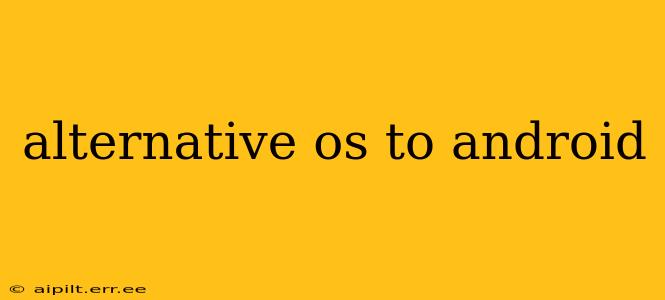Android reigns supreme in the mobile operating system (OS) world, but a vibrant ecosystem of alternatives offers compelling choices for users seeking different experiences or prioritizing specific features. This exploration dives into the leading Android alternatives, examining their strengths, weaknesses, and ideal user profiles. We'll also tackle some frequently asked questions to provide a comprehensive overview.
What are the best alternatives to Android?
Several operating systems compete with Android, each catering to a niche market or offering a unique approach to mobile computing. The "best" alternative depends heavily on individual needs and priorities. However, some of the most prominent contenders include:
-
iOS (Apple): The undisputed king of user-friendliness and a premium ecosystem, iOS boasts a sleek interface, robust security, and a vast app store. However, it's exclusive to Apple devices, limiting hardware choices and often coming with a higher price tag. Its closed-source nature also means less customization compared to other alternatives.
-
HarmonyOS (Huawei): Huawei's answer to Android, HarmonyOS is designed for seamless integration across devices, from smartphones and tablets to smartwatches and TVs. It offers features like distributed multitasking and improved power efficiency, but its app ecosystem is still developing, potentially limiting app availability compared to Android or iOS.
-
KaiOS: Designed for feature phones and budget smartphones, KaiOS offers a lightweight operating system with basic functionalities and impressive battery life. It supports popular apps like WhatsApp and YouTube, making it a viable option for users who prioritize affordability and longevity.
-
Sailfish OS: A Linux-based OS focused on privacy and security, Sailfish OS boasts open-source architecture, strong customization options, and a unique user interface. However, its app ecosystem is relatively small, and its availability is limited.
What is the most similar OS to Android?
While no OS is a perfect replica of Android, HarmonyOS arguably presents the most similar user experience in terms of interface and functionality. Both utilize a similar app structure and offer many comparable features. However, HarmonyOS distinguishes itself with its focus on cross-device connectivity.
Is there a better OS than Android?
The question of a "better" OS is subjective. Android's strengths lie in its open-source nature, vast app ecosystem, and widespread device compatibility. However, iOS excels in user-friendliness and security, while HarmonyOS prioritizes cross-device integration. Sailfish OS prioritizes privacy and customization. The "best" OS depends on individual priorities. If security and ease-of-use are paramount, iOS might be preferable. If you value customization and open-source principles, Sailfish OS or a custom Android ROM might be more appealing. For seamless integration across multiple devices, HarmonyOS shows promise.
What is a good alternative to Android for privacy?
For users prioritizing privacy, Sailfish OS is a strong contender. Its open-source nature and focus on security provide more control over data and offer a greater level of transparency than many closed-source alternatives. However, it's important to note that no OS is entirely impervious to security threats; diligent user practices are always crucial.
What is the best open-source alternative to Android?
Several open-source projects exist, but they often require technical expertise to install and manage. Many users opt for custom ROMs based on Android’s open-source project (AOSP), enabling significant customization but also potentially compromising stability and security if not handled correctly. Sailfish OS also offers an open-source alternative but with a different approach to design and functionality.
Conclusion
The landscape of mobile operating systems extends beyond Android, offering various alternatives with unique strengths and weaknesses. The best choice depends entirely on individual needs and priorities. Consider factors like app availability, security concerns, desired level of customization, and budget when making your decision. This exploration aims to provide a solid foundation for informed selection, empowering users to choose the OS that best aligns with their specific requirements.
